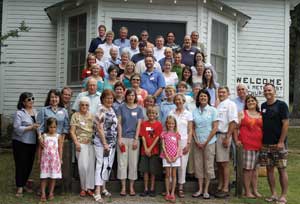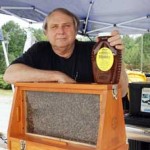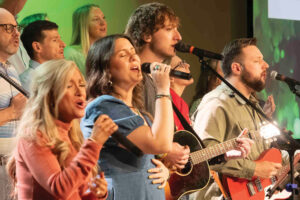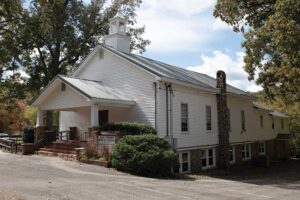
 By Carolyn Stern
By Carolyn Stern
Photos by Jerry Martin
Traveling from Pell City or Ashville to Oneonta on US 231 North, you might easily miss a road sign on the right, just after mile marker 242. It reads “Beason Cove Road.” However, if it catches your eye, and you turn, following the narrow road down a hill and across Muckelroy Creek, you enter a valley that holds an enduring history of a family and of the area.
Beason Cove Road runs along the base of Chandler Mountain, parallel to US 11 North. A number of genealogies based on recorded documents shows that a son of the original St. Clair County settler brought his family to what became known as Beason’s Cove.
Today, almost two centuries later, a family reunion is held annually on the second Sunday in June (even in 95-degree temperature). These are folks who know who their “people” were and are. The meeting place for these reunions is a small white-painted, steepled church with an adjoining cemetery where many family members are buried. The church was, and still is, known as Union Church or Beason’s Union Church.
The first structure was made of logs. It was torn down in the late 1800s and replaced with a wooden building that was destroyed by fire on the second Saturday in June 1919. The present building was constructed in 1921.
But let’s back up a bit. How and when did the Beeson/Beason family happen to settle in St. Clair County, and who first came to the Cove?
Capt. Edward Beeson, who was born in Guilford, N.C., joined the army of the Revolution in the spring of 1778. He was commissioned captain of a company of foot soldiers. In 1814, after Gen. Andrew Jackson negotiated a treaty to end the war with the Creeks, more than 20 million acres of Creek land became available to settlers. Much of it was in the area that became known as Alabama.
Beeson was one of the many people who moved their families further south to take advantage of the open land and settled in St. Clair County, between what is now Ashville and Steele.
Records show he was married three times and had nine children. He later moved to Etowah County, where he was buried in Carleton Cemetery in the Aurora community. In 1925, his grave site was moved to the Beeson/Union cemetery. His military marker is located there, as is a large memorial marker installed in recent years by his descendants.
One of his sons, Curtis Grubb Beason, who was 12 years old when he came to St. Clair County, was the one responsible for the settling of the Cove area and spreading the ownership among his children.
Curtis married Martha Clark, who was part Creek Indian. Her parents were Henry and Margaret (Lightfoot) Clark. The couple had 10 children, five girls and five boys. Eight of them eventually owned farms in Beason Cove. Curtis Grubb was an influential man of the time. He held the office of county tax assessor and collector in 1843-1844. He was state senator from St. Clair County in 1863 and a delegate to the Constitutional Convention of 1865.
Around 1840, Curtis built the two-story Beason plantation home that you can see by taking the first left turn after entering the Cove. The last of the Beasons to live in the plantation home were Miss Allie Beason and Curtis Hinton, son of Laura Beason Hinton. When both died, the house passed out of the family. The once narrow, dusty road is now known as Curt Hinton Drive (an alternate route to the Horse Pens 40 access road). Trees flanking both sides of the sparsely populated roadway produce brilliant autumn color and thoughts of days gone by.
Curtis gave the land on which the church stands to his son William Spruell Beason. William Beason and his wife, the former Juliann Dearman, gave the property to the Methodist Episcopal Church of the United States on Oct. 10, 1880. Later, the property reverted to the family. William and Juliann were the grandparents of the Doctors W.D. and R.C. Partlow, who were connected with Brice Hospital and Partlow School for a number of years.
In the past few years, Beesons have given their support to Samford University, the Birmingham Museum of Art and other causes. Alabama State Sen. Scott Beason is a descendant, and his father, Tom, is president of the Beason Family Association, which maintains the church property today. Other family members make vital contributions to education, medicine, government, agriculture, the military, religion and business.
Edith Bowlin Tucker is the great-great-great-granddaughter of Curtis Grubb Beason, and many of those who come to the reunions are “cousins” of hers.
She writes in a summary of the family’s history, “William S. Beason’s home was a big log house located just beyond the church.” Her nephew, Jerry Payne, and his wife, Janice, built a log house on the corner of Beason Cove Road and US 231 in 2001.
Jerry and Janice are the only Beasons who live in the Cove now. Their home is just a short distance from the church and cemetery. Throughout the year, Jerry takes care of the church grounds. “I feel like that’s what my mother would want me to do,” he says. “Living here gives me a real connection to our family’s story.”
But wherever the parents, grandparents and, of course, the cousins live, they are sure to continue the proud history of the Beesons/Beasons, no matter how their names are spelled.















